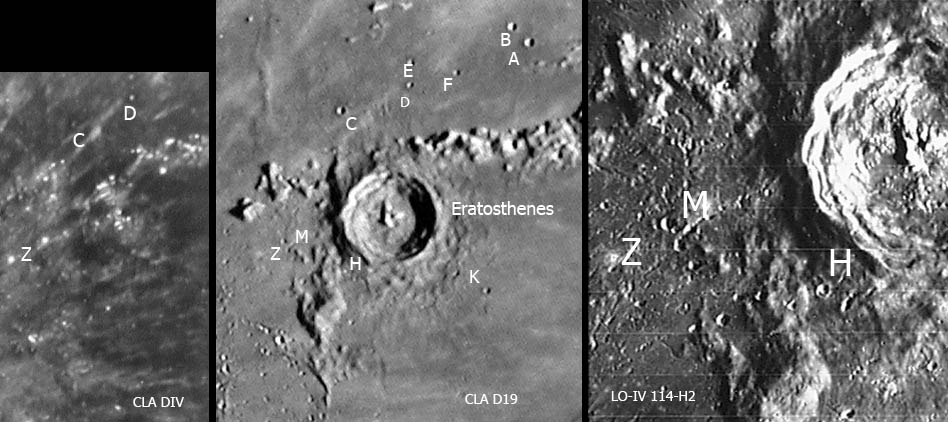February 27, 2005
One Crater’s Nomenclature
Image Credit: Consolidated Lunar Atlas and Lunar Orbiter IV |
|
One Crater’s Nomenclature Lunar nomenclature is such a trivial bugaboo. It is trivial in the sense that it has no physical reality and it is much less interesting than the craters, rilles, mountains it denotes. But clear, well defined nomenclature is essential if you want to efficiently communicate anything about those features. Nomenclature is a bugaboo because it has varied so much over hundreds of years, and there is no absolutely accurate image map of it. [If you think that the Clementine Lunar Atlas negates this last clause, see Danny Caes’ list of corrections.] As an experiment, I have tried to make an unambiguous photographic depiction of the lettered craters associated with just one crater - Eratosthenes. This proved more time consuming and difficult than I expected. The central image shows Eratosthenes and the 10 associated lettered craters. This image illustrates the first problem – what image is best to show all the lettered features? The resolution and scale have to be good enough to see the smallest craters, and the illumination has to be high enough that none of the craters are hidden by shadows. Although most of the lettered craters are unambiguous, H, M and Z are not at this scale. The right image is a piece of a high resolution Lunar Orbiter IV frame that shows that H is indeed a crater, although it looks like a rare case of one small crater forming nearly on top of another of the same size. M is also a crater – in fact it is seen more clearly on the Consolidated Lunar Atlas image. But Z is more mysterious. In the middle image it appears as a tiny white spot, and the LO-IV view shows an even tinier pit at the center of the spot. The reason for the lettering of this crater is revealed by the full Moon CLA image on the left. Eratosthenes Z is a very bright white spot. But that image also shows other conspicuous white spots that have not received designations. In my mind, H, M and Z should not have been lettered. They are very minor, imperfect features that have not been the subjects of study and probably won’t ever be. In the mean time they confuse people who might want to identify them – they are examples of poor, unneeded nomenclature! Finally, what was my source for this nomenclature? It is official IAU, but the most flawless depiction of that is the famed Rukl Atlas of the Moon. Since Rukl exists, why worry about making a nomenclature image map? Rukl is based on drawings, not the Moon we see in the eyepiece and in images. And Rukl accepts the IAU nomenclature – I think the flaws should be corrected. I am a nomenclatural troublemaker! Technical Details: Eratosthenes Lettered Craters – Diameters and Depths Eratosthenes 58.3 km 3.43 km A 5.9 1.29 B 5.4 1.14 C 5.3 0.95 D 4.1 0.83 E 3.9 0.78 F 4.2 0.88 H 3.1 K 4.6 0.86 M 3.6 Z 0.5
Diameters and Depths from Unpublished Lunar Orbiter Catalog of Lunar Craters (Wood & Andersson, 1972). Related Links: Yesterday's LPOD: A Warhorse, Again Tomorrow's LPOD: A Fractured Plateau |
|
Author & Editor: COMMENTS?Register, Log in, and join in the comments.
|




